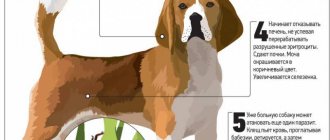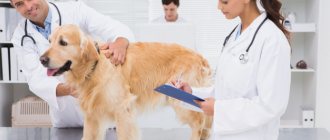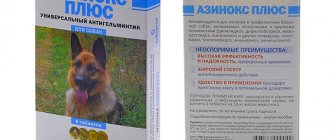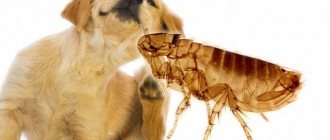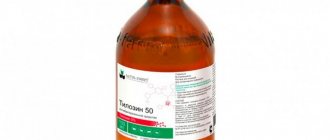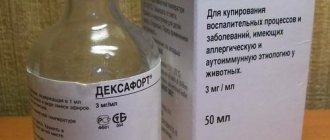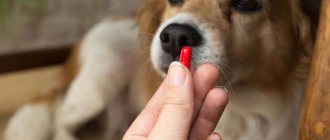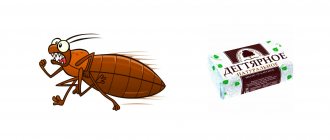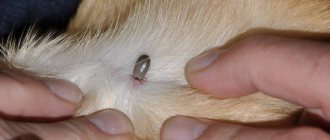- How to determine the type of bleeding?
- Sequence of actions, first aid:
- What ointments are used to treat wounds?
- The dog's wound is festering - what should the owner do?
Active dogs sometimes get into dog fights.
Therefore, you need to know what to do if your dog gets into a fight while walking. Even a well-mannered dog can become a victim of a pack of stray dogs, which sometimes attack pets in a pack. As a result, the dog’s wound may take a long time to heal and be a reminder of the unpleasant incident. To prevent this from happening, choose safe routes and parks for walking. Treating wounds in dogs requires a lot of patience from both the dog and its owners. If your pet is injured, do not panic, do not cry or scold your dog.
If there is an owner next to the dog that bit your pet, ask if the dog has a veterinary passport and a current rabies vaccination. Typically, the consequences of such dog fights are bitten and lacerated wounds. Every dog owner needs to know how to provide first aid to a pet.
First, you need to assess the nature of the wound, how big it is, determine whether there is bleeding, if so, what kind of bleeding it is and how strong. If the wound turns out to be minor, then it will need to be treated with an antiseptic. If it is of a serious nature (there are bites, torn edges, etc.), then you must urgently consult a veterinarian!
Sequence of actions, first aid:
- Shave or trim the fur around the injury.
- If dirt gets into the wound, after removing the hair, wash the wound with antiseptics.
- Disinfect with hydrogen peroxide solution or chlorhexidine. If there are no medications nearby, use running water.
- Penetrating trauma to the chest or abdominal cavity - immediately take the animal to the veterinary clinic. A specialist will tell you how to treat a dog’s wound. You need to try to stop the bleeding, disinfect the injured area, and apply a bandage.
After providing first aid, immediately contact a veterinary clinic, where the doctor will examine the animal, perform surgical treatment of the wound,, if necessary, apply stitches or install a drainage system, and prescribe a course of antibiotic therapy.
Do not neglect a professional examination, even if in your opinion the wound is trivial. In most cases, after poor-quality treatment and incorrect actions on the part of the owner, complications occur in the form of abscesses, wound decay, sepsis and long healing.
In the case of wounds accompanied by bleeding, untimely assistance can cost the life of your pet.
Antibiotics for animals with purulent wounds
A course of antibiotic therapy for purulent open wounds should be prescribed by a veterinarian. In complex therapy for four-fingered patients, antibiotics of the penicillin, cephalosporin, tetracycline series, ampicillins, and macrolides are prescribed orally to prevent infection. Therapeutic therapy for purulent wounds should also be selected taking into account the phases of the wound process.
Antibiotics are selected based on the results of microbiological tests and bacteriological studies aimed at determining the sensitivity of pathogenic flora to certain drug substances. Additionally, in the initial stages of treatment of purulent wounds in dogs, pharmacological anesthetics are used.
For local treatment, a good wound healing effect is noted after the use of antibacterial ointments, gels, and creams. Dogs are prescribed:
- Levomikol.
- Liniment Syntomycin 5%.
- Tetracycline 3% ointment.
- Ranosan.
- Betadine.
- Safroderm-gel.
- Sangel.
- Gentamicin ointment.
- Septogel.
Levomikol ointment is often prescribed for purulent wounds and soft tissue damage in dogs.
The above pharmacological agents have a pronounced bactericidal effect, relieve swelling, prevent degenerative-destructive processes in tissues, and accelerate regeneration processes. Used for the treatment of pustular lesions of soft tissues, furunculosis, purulent abscesses in animals, in the presence of open wounds infected with pyogenic flora.
What ointments are used to treat wounds?
The owner should always have Chlorhexidine solution, Levomekol, Ranosan ointment, or any other ointment with a wound-healing effect, bandages, and napkins on hand to provide first aid. Other drugs are prescribed by the attending physician depending on the specific case.
If you go hunting or on a multi-day hike with your dog, it is better to take the necessary medications with you than to think later about how to help your pet. It is worth remembering that the animal’s wound should always be washed thoroughly, without leaving hair, dirt, crusts, etc. in it. otherwise, all treatments will only be harmful, and the wound will soon begin to fester.
Types of wounds in dogs
Depending on the characteristics of the object causing the wound, wounds are classified into nine types.
Table 1. Types of wounds in dogs
| Type of wound | Description |
| Scratches with abrasions | They arise as a result of a dog touching an object or plant while trying to vigorously scratch a certain area of the body. Some animals injure themselves by biting fleas or trying to get rid of mats and pieces of matted fur. |
| Cuts | Appear on the pet's body upon contact with various objects with sharp edges. It happens, for example, that the tissues of the mouth are injured by the broken ends of chewed bones |
| Severe bites from other animals | Wounds of this nature are most often subject to inflammatory processes. This is due to the fact that from the very beginning the surface of the damaged area of the body is contaminated with substances released from the aggressor’s mouth |
| Splinters | These foreign particles usually get into the paw when the dog is running outside. However, sometimes they have to be removed even from the tissues of the cheeks or tongue, because these pets love to chew wooden pieces of furniture |
| Injuries resulting from an accident | According to experts, it is in these cases that animals receive the most complex injuries, which may even be incompatible with life. |
| Puncture wounds | Damage occurs due to contact with a sharp object that can quite easily pass through living tissue. Depending on the nature of the damaging product, wound channels can be smooth or rough |
| Chopped wounds | They are a type of injury characterized by serious destruction of fairly deep tissues, as well as damage to the walls of lymphatic and blood vessels, and lacerated nerves. In many animals, joints and other bone elements are crushed |
| Bruised wounds | They occur after the dog’s body is exposed to blunt objects. In this case, as a rule, multiplication and crushing of not only the epidermis, but also deeper muscles occurs. In addition, minor blood loss occurs |
| Lacerations | Applied with a pointed object. For pets, they are dangerous due to rupture of tendons and ligaments, as well as various infections entering the body. |
It happens that dogs receive combined wounds. Moreover, each injury is accompanied by the risk of infection. After all, dirt and dust, fluff and hair, rust and foreign bodies penetrate inside damaged skin along with foreign objects. Therefore, even a small wound must be treated with an antiseptic.
There are special antiseptics for dogs
It should be noted that you should treat yourself at home only those wounds that are superficial and do not pose the slightest danger to the life of your pet.
The dog's wound is festering - what should the owner do?
It happens that the owner does not know how to treat an open wound on a dog. Or he doesn’t immediately notice that the dog has a large splinter or wound that is invisible under the fur. In this case, the wound may begin to fester. Treatment of such wounds becomes more complicated and requires immediate intervention by a veterinary specialist. Before contacting a doctor, such a wound can be washed with hydrogen peroxide, the hair must first be cut and pus and dirt removed.
Remember that the life and health of your pet depends on your actions! If the trouble happened far from the city and you cannot see a doctor soon, contact him by phone and he will give you recommendations regarding your case.
Purulent wounds
All wounds except operating wounds are infected. That is, pathogenic flora penetrates into the damaged area. For example, bite wounds are almost always contaminated with pathogenic agents. Under favorable conditions, microorganisms actively multiply quite quickly, provoking acute inflammation.
As a rule, the appearance of purulent wounds in dogs is promoted by: Klebsiella, Pseudomonas aeruginosa, Escherichia coli, streptostaphylococci. During their life, bacteria produce endotoxins, which not only destroy tissue and provoke inflammatory processes in the deep structures of the dermis, but also poison the entire body of the pet.
Wounds can be superficial, deep, or penetrating. After injury, the so-called wound process is activated, which occurs in three phases:
- inflammation;
- regeneration;
- scar formation, epithelization.
Dogs lick small abrasions and small wounds on their own. The acceleration of regeneration is facilitated by bactericidal enzymes contained in the saliva of pets. Purulent wounds require longer complex treatment and a competent approach.
Important! You can provide first aid to your dog at home. Further therapy should be prescribed by a veterinarian. In order not to aggravate the situation, you should not self-medicate. Antibacterial drugs should be selected by the attending veterinarian based on the results of diagnostics and microbiological tests.
In traditional veterinary medicine, to accelerate the healing of purulent, infected wounds in dogs, symptomatic treatment and antibiotic therapy are prescribed. Antibacterial ointments and gels are used for local treatment. creams, liniments. Additionally, pharmacological drugs in tablets and complex, broad-spectrum antibiotics may be prescribed.
Features of the treatment of lacerated and weeping wounds in dogs
After damage is caused, regardless of its severity, various pathogenic microorganisms immediately accumulate on the surface of the skin around the wound. If the injury is torn and affects the deep layers of tissue, then after a couple of days the dog experiences a progressive inflammatory process.
Weeping wound on a dog
An equally common cause that leads to inflammation is failure to follow the rules of asepsis or the use of inappropriate antiseptics when the integrity of the skin and soft tissues is damaged. In this case, exudate containing blood plasma and lymph, as well as leukocytes, lymphocytes and other products of the inflammatory process is released from the wound channel. This substance provides a favorable environment for the proliferation of pathogenic bacteria and microorganisms. As a result, the formation of a weeping injury is observed. The wound emits a specific smell. Many owners note apathy and depression in their pet.
Lacerated wound in a dog
Carrying out therapy in such a situation involves carefully removing all exudate and crusts formed on the surface of the damaged area. After this, it is necessary to treat the area with a disinfectant. If your dog experiences severe itching of the skin and pain, you should consult a veterinarian who will recommend the most appropriate analgesics and antihistamines. Usually, Tavegin or Suprastin is prescribed, the active ingredients of which slow down the synthesis of histamine-like substances, thereby reducing the amount of exudate accumulating inside the wound.
Erythromycin ointment also effectively acts on harmful microbes, healing the wound
To eliminate pathogenic microflora, it is necessary to cover the affected area with ointments that have an antibacterial effect. Effective are “Vishnevskaya ointment”, “Tetracycline ointment”, and “Levomikol”. In severe cases, the animal is additionally given broad-spectrum antibiotics.
In addition to ointments and antibiotics, special sprays that can be found in veterinary pharmacies promote wound healing. Below are some brands of such drugs.
Sprays for treating wounds in dogs
